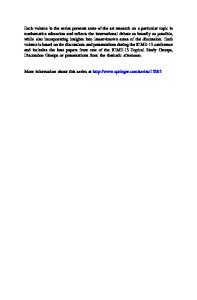Language in Mathematics Education Research
In the past few decades, language has become an active focus of investigation in educational research, including research in mathematics education. Such a focus is a symptom of a relatively recent paradigmatic shift whose chief characteristics are a new u
- PDF / 698,030 Bytes
- 39 Pages / 612 x 792 pts (letter) Page_size
- 61 Downloads / 457 Views
8. LANGUAGE IN MATHEMATICS EDUCATION RESEARCH
INTRODUCTION
In the past few decades, language has become an active focus of investigation in educational research, including research in mathematics education. Such a focus is a symptom of a relatively recent paradigmatic shift whose chief characteristics are a new understanding of the student and an increasing awareness of the complexities of learning contexts, such as, notably, the complexities arising from cultural and linguistic diversity. This paradigmatic shift appeared as the field attempted to move away from the two main models that emerged and evolved during the educational progressive reform of the early 20th century (see also Lerman, 2006). The first of the two main models was the “transmissive model.” With its intellectual origins in behaviourism, this model was promoted by bureaucratic pedagogues who focused on implementing mass education to efficiently address the demands of industrial and business production (Tyack, 1974). Two of the contemporary heritages of this model are a methodical and detailed curriculum and the obsession with systematic “objective” assessments. The second main model was the “childcentered” educational model. Intellectually rooted in a romantic pedagogy, this model focused on the child’s interests and intellectual potential. “Progressivism,” as this model came to be known, promoted the idea that “knowledge is … [a] personal acquisition, obtained by learning from experience” (Darling & Nordenbo, 2002, p. 298) and meant “promoting discovery and self-directed learning by the student through active engagement” (Labaree, 2005, p. 277). Although language is not absent from these models, it does not appear as a central research problem. And when it does appear, it is generally related to problems surrounding the investigation of students’ conceptualizations. Language is considered as a kind of window to see indirectly what is happening in the student’s mind as, for instance, in Piaget’s conservation tasks. When students’ conceptualizations are perceived to be incorrect, language is often then seen as an obstacle or barrier to the effective communication of the desired knowledge or structures. Language, however, is clearly more than a window or an obstacle; language, talk, text and the production and interpretation of symbols are integral to the creation of learning, teaching and assessment, particularly in mathematics. In Piaget’s conservation tasks, for example, language is not simply a neutral conduit for conveying thoughts between experimenter and subject; the tasks are constituted through linguistic Á. Gutiérrez, G. C. Leder & P. Boero (Eds.), The Second Handbook of Research on the Psychology of Mathematics Education, 275–313. © 2016 Sense Publishers. All rights reserved.
L. RADFORD & R. BARWELL
processes. For language to move to the forefront as an educational research problem on its own, it was necessary to move beyond the conception of humans as Cartesian problem solvers promoted by progressive models. This move, from which em
Data Loading...











